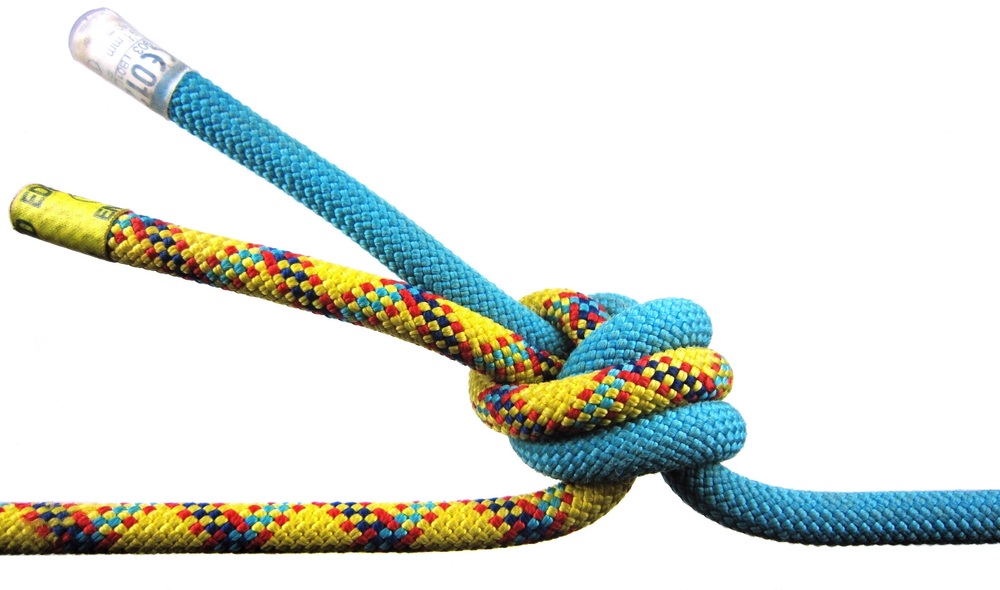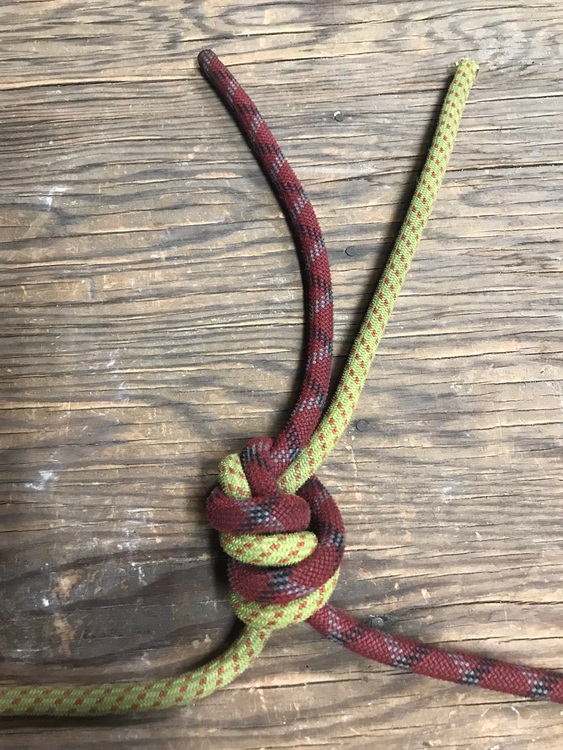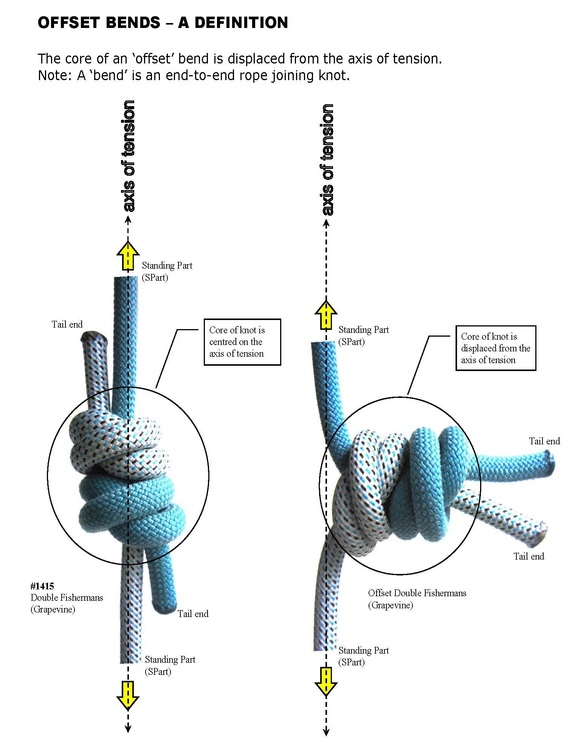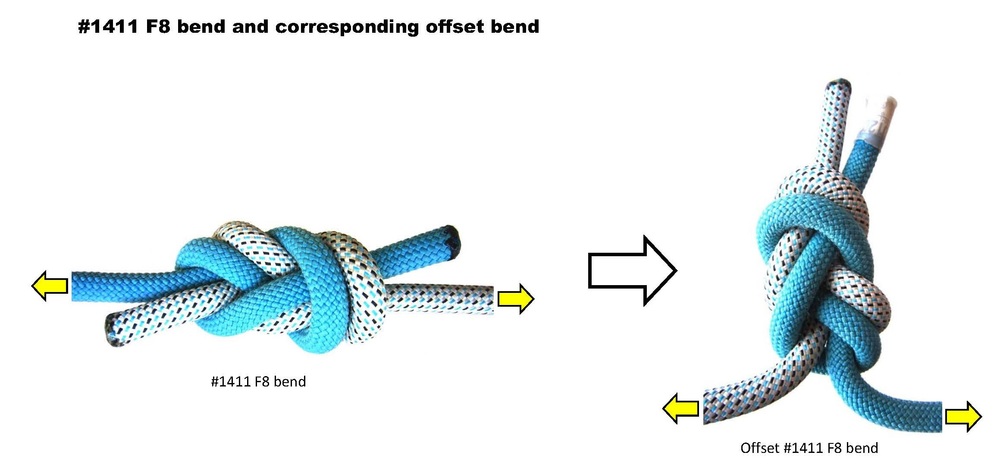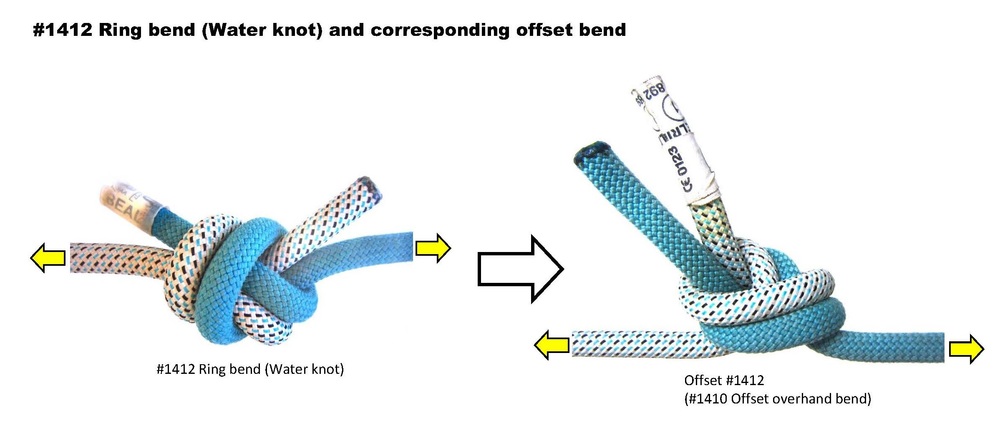Half-hitch back up to flat bends
|
|
Chris K wrote: This is a good article, especially the part where Donahue outlines situations where a flat overhand may not be appropriate: Donahue wrote: So is a half-hitch back-up on a flat overhand a suitable alternative to the barrel knot (or double fisherman's) in some, or all, of these scenarios? |
|
|
I believe it is a suitable back up to the standard situations where you would want to use the flat overhand. Donahue himself uses the flat overhand with an overhand behind it on one strand. But I would say adding a half hitch to most climbing knots would not add much, if any, security. |
|
|
In a recent issue of the Alpine Club of Canada's Gazette, this article describes a method to back-up flat 8 and overhand bends with a half-hitch. The article itself provides scant description of testing this method, and I can't find any other sources supporting this as an effective method to keep either bend from rolling and failing. While understanding that a flat overhand with sufficient tail doesn't need a back-up has anyone tested this method or have experience with it? In providing a direct answer to your question: |
|
|
Thanks Mark for the analysis, and your detailed diagrams. Climbing ice there is ample opportunity to encounter wet, icy ropes with slippery dry treatments and some of the other loading factors outline by Donahue. |
|
|
Nathan Sullivan wrote: If I'm reading correctly, the Petzl RAD Line page shows the flat figure 8 taking more force to capsize and generally being stronger in that particular cord versus the EDK. Interesting. They do point out the advantages of the EDK in getting stuck less, being less sensitive to proper dressing, and being easier to untie after load. And, that their results are only valid for that cord, of course, not other ropes and cords. The issue with the fig8 is that (as the petzl results show) it is more sensitive to not being tightened by the climber. If you compare at what petzl considers tightening (4 separate steps) and what most climbers (just pull the knot once) you can see the issue. When a fig8 rolls, it also eats more tail. I once tested a poorly tightened fig 8 with body weight to see what would happen. It rolled. The poorly tightened overhand didn't |
|
|
David Coley wrote: BRAVO for pointing this out! (For the most part, generalizations rule the day w/o regard to the detailed facts.) Indeed, though I am among those who propagated a call of DANGER for the offset fig.8 knot, I came to realize that in my personal playing around with various candidate solutions to this abseil-ropes-joining problem --using a crummy 5:1 (and variously just 2:1) pulley-- I'd NOT been able to show the supposed problem. But one can set the knot incorrectly (for this offset loading); and one can realize the need and set it appropriately, in which case it will take an unreasonable force to capsize it. |
|
|
Bob Harrington wrote: Here’s another option that has the advantages of the overhand (simplicity, compactness, offset from the rope axis), but doesn’t capsize. Tie it by tieing an overhand, then pass the ends through the loop a second time. It’s been tested on a slow pull machine, and does not capsize. I learned this at a rope rescue course last year in Ouray, Colorado. DAV calls this the Paketknoten I believe. I've been using it as well for both raps and joining threaded cord (Dolomites or Cordalete tie offs. Eastern Alps use is common is my understanding). |
|
|
FosterK wrote: In a recent issue of the Alpine Club of Canada's Gazette, this article describes a method to back-up flat 8 and overhand bends with a half-hitch. I should remark that a better course to take than is shown in this article --which knot I doN'T like-- is to push the tied EDK **through the half-hitch** (thus forming one more overhand in the HH-ing strand). Probably best is doing this with what is shown in the lower knot, where the golden rope is making the choking and purple rope is forming the HHitch, and so the pushed-through-HH added overhand will be in the purple rope which then has the choking duty, the pre-tied EDK bearing into it not with offset loading but as a double-strand stopper knot. Call the structure an "overhand-guarded EDK", for quick comprehension. German (Autrian?) Jost Gudelius presented this knot some decade or so ago, and repeated essentially a sometime prior recommendation of it by Austrian Heinz Prohaska (who was sharing thoughts w/Franz Bachmann, who'd suggested the offset grapevine bend. Cf. [url] gudelius.de/spst.htm[/url] |
|
|
Mark Gommers wrote:In the first instance, he describes these end-to-end joining knots as being 'flat' - which is technically incorrect. Not disagreeing with the rest of your post, but that's not what "flat" means in this context. When you call a knot "flat", that doesn't mean it's flat as in a sheet of paper, it means that it's a knot which can be tied with the end of one strand, but in the case of the flat knot, is tied with the ends of two strands with the ends pointing the same way. So an overhand knot tied with two ropes with the ends pointing the same way is a flat overhand. A figure 8 tied with two ropes with the ends pointing the same way is a flat figure 8. The knot Bob Harrington posted is a flat double overhand. |
|
|
When you call a knot "flat", that doesn't mean it's flat as in a sheet of paper, it means that it's a knot which can be tied with the end of one strand, but in the case of the flat knot, is tied with the ends of two strands with the ends pointing the same way. Your proposition does not hold up to scrutiny - and is incorrect. I'd venture a guess that all flat knots are offset knots, but not all offset knots are flat knots, but my knowledge of knots isn't broad enough to be confident in that claim. I recommend that you read the paper on offset knots - the link to which I gave in a previous post. |
|
|
David K wrote: And I'm not --until now-- really disagreeing with what is intended by this (ab)use of "flat", just that there's an apt adjective --viz.,. "offset"-- doing the job w/o such dubious connection. For example, all these knots are "bends" because they join two ropes. So a flat figure 8 and a flemish bend could both accurately be called "figure 8 bend", even though they're very different knots. Let's ditch the "bend" = "end-2-end" assertion : which wasn't true at the time it was promulgated by Ashley, and doesn't hold water with the use of "to bend" which was more popular back in the day. Of course, all knots books parrot the same stuff, nonsense or otherwise (well, most all)! kN* |
|
|
Mark Gommers wrote Which lacks the "Triple-T Fisherman's" knot as presented by Jost Gudelius (and I forget an Englishism for what Heinz called it), and is worth presenting as one of the solutions available --even tested(!). In the case where rope-A makes the choking & finishing overhand, with rope-B in-between these two, one has a knot that can be seen as *guarding* the EDK/offset water knot with an overhand or one that ties off the EDK's (choking!) tail. Though, in the former case, were ropes of different sizes, the implication could be that the orientation isn't good (as the choking OH of the EDK should be the thinner rope, and that would imply that the thicker were making the *guard* OH --not the better choice. |
|
|
Mark Gommers wrote: Your proposition does not hold up to scrutiny - and is incorrect. Why is that exactly? Because you said so? I assure you that the meaning I described is what people mean when they say "flat" in "flat overhand" or "flat figure 8". Which is more likely: there's some massive conspiracy to mislead the public into believing these knots are 2-dimensional when everyone can see they aren't? Or that the word is being used as a jargon word that has a different meaning in this context? Look, I'm not saying the terminology is perfect. Your criticism that the term is ambiguous holds some water. But to simply say that "flat" doesn't mean something that many people have used it to mean, is a bit weird. It's fairly obvious that Orville Miskew isn't saying the knots are two-dimensional, and it's a bit unfair to attack him because he uses the word "flat" in the same way people have used it for decades, instead of the way you decided everyone should use it. |
|
|
knudeNoggin wrote: And I'm not --until now-- really disagreeing with what is intended by this (ab)use of "flat", just that there's an apt adjective --viz.,. "offset"-- doing the job w/o such dubious connection. What I don't agree with is Mark Gommers deciding that the word means "two dimensional" and then saying Miskew is incompetent because he used the word "flat" to describe a three-dimensional knot, when it's clear Miskew didn't mean that the knot is two-dimensional. It's reasonable for Gommers to point out the problems with the existing term and propose better terms, but it's an entirely another thing for him to pretend the existing terminology doesn't exist. Now, your assertion of "it means that it's a knot [that] can be tied ... with one strand" is a novelty, IMO --and w/o importance. I think the importance here is what I said above: it tells you how to tie the knot. Your definition would exclude the offset (dbl)fisherman's knots as "flat"; but they are possible solutions to the general problem. Yeah, that's an example I couldn't think of previously: it's an offset knot that isn't a flat knot. Having now read the paper Mark Gommers posted, I can see that by his definition, "offset knots" doesn't include the alpine butterfly. Fine, maybe that's better terminology, but let's not pretend that now since Mark Gommers proposed this newer terminology, that it's the only terminology that has ever existed. People have been calling many of these "offset" knots flat knots for a very long time, and it's not because all those people were stupid and thought that the knots were two dimensional. |
|
|
I haven’t examined this thread in great detail—just skimmed it—but is there any significant history of rappel knots failing? Have they failed because they weren’t strong enough? Or was it because they were poorly tied? |
|
|
David k, What I don't agree with is Mark Gommers deciding that the word means "two dimensional" and then saying Miskew is incompetent With due respect, I would reply that I never stated these words...you are extrapolating something you have surmised. |
|
|
Malcolm Daly wrote: I haven’t examined this thread in great detail—just skimmed it—but is there any significant history of rappel knots failing? Have they failed because they weren’t strong enough? Or was it because they were poorly tied? Here are four accidents reported in the ANAM/ANAC that appear relevant to answering your question (either unknown knots or offset F8 bends without backups): http://publications.americanalpineclub.org/articles/13201214416http://publications.americanalpineclub.org/articles/13199006201 http://publications.americanalpineclub.org/articles/13201214376 http://publications.americanalpineclub.org/articles/13199507102 I noted that the ACC (a club which I'm a member of), has published a proposed method of securing knots like those described in the accidents above. The proposed method appeared to be novel and an internet search did not turn-up this method anywhere else. Given the expertise available on this forum and that this information was disseminated to over 11,000 ACC members, it was worth reaching out to see if anyone had analyzed the method, or had critiques of it. Doubly so since the original author did not include any meaningful analysis of testing. That meets my standard of being worthy of discussion. |
|
|
Thanks for the links. Incidences 2&3 appear to be the same. The fourth incident appears to be a case of the rappeller tying a knot we know is unsafe. The first two are probably just bad or inattentive knot tying. I stand by my above post: I still see no evidence of a well tied flat overhand ever failing. Rather than going on and on about all the various iterations of strong, backed-up and complicated knots, I think we’d be better served by getting everyone to tie the same knot— flat overhand—that is easy to tie, easy to inspect and strong enough. |
|
|
Malcolm Daly wrote: Thanks for the links. Incidences 2&3 appear to be the same. The fourth incident appears to be a case of the rappeller tying a knot we know is unsafe. The first two are probably just bad or inattentive knot tying. I stand by my above post: I still see no evidence of a well tied flat overhand ever failing. Rather than going on and on about all the various iterations of strong, backed-up and complicated knots, I think we’d be better served by getting everyone to tie the same knot— flat overhand—that is easy to tie, easy to inspect and strong enough. Fixed the links for you. Some of us prefer to have the right tool at the right time. There are some situations - two person loads, avalanche, icy or dry coated ropes - which may reduce the security of the overhand offset knot. Teaching one method if great for beginners or people who will stay within a narrow context of climbing (saying, rock climbs in dry weather) - but ultimately, applying the right tool at the right time is as important to staying safe as knowing the preferred method for most contexts and executing it well. |
|
|
Mark Gommers wrote: I would comment that climbers are (in general) users of knots... they aren't (in general) knot theoreticians (or knotting 'experts'). I would suggest that you're being rather generous to knot theoreticians by comparing them to computer technicians and car mechanics. It's true that, as a computer user, if I have a problem with my computer, I go to a computer technician. It's also true that, as a car user, if I have a problem with my car, I go to a car mechanic. And it's also true that, as a knot user, if I have a problem with my knot, I go to myself, because a) the handful of knots we're discussing here aren't nearly as complicated as a computer or car, and b) because if I don't fix the knot, I fall a long ways and probably die. In your analogy, climbers are the computer user AND the computer repair technician, the car user AND the car mechanic. In your analogy, the knot theoretician isn't relevant. In the first instance, he describes these end-to-end joining knots as being 'flat' - which is technically incorrect. Which is more likely?
The car theoretician says: The concept of 'Offset' was first published by Clyde Soles in his book (in consultation with one of the world's experts on knotting theory). Clyde Soles doesn't get to decide what the "correct" terminology is for everyone either. "Flat overhand" predates his term by decades and is much more widely used, and I'm not convinced that there is any widespread confusion about the ambiguous term "flat", nor am I convinced that "offset" is significantly less ambiguous. If you can define "offset" to make it clear, you could spend that time defining "flat" and be just as clear, and use terminology that people are already using. What I have done is written a paper to try to bring together all of our collective knowledge and understanding of knot theory as it relates to #1410 (Offset overhand bend / Offset Water knot). And I much appreciate the parts of your paper where you act as a knot scientist, who experiments and collects data, which is very useful--that's actually knowledge you have which I didn't have before I read your paper. However, your opinions on what the correct terminology is aren't "knowledge", they're your opinions. With due respect, I would reply that I never stated these words...you are extrapolating something you have surmised. You literally accused him of not knowing the difference between two dimensional and three dimensional objects, dude. Maybe you didn't actually call him the word "incompetent", but this is another case where the words already used aren't ambiguous. |

 Continue with onX Maps
Continue with onX Maps Sign in with Facebook
Sign in with Facebook





















